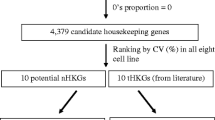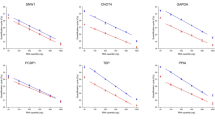Abstract
Background: Differences in gene expression are frequently encountered in malignant tissues, and have been intensively studied as they can reflect different experimental or clinical conditions. Quantification of the often subtle changes in messenger RNA content is performed through comparison with the expression of endogenous controls. The appropriate choice of these endogenous controls (e.g. housekeeping genes) is critical for meaningful quantitative RNA analysis. The most important characteristics of housekeeping genes are that they are present in all cells and that their expression levels remain relatively constant in different experimental conditions. However, no single housekeeping gene always manifests stable expression levels under all experimental conditions. Therefore, it is necessary to characterize the suitability of various housekeeping genes to serve as internal RNA controls under particular experimental conditions where transcription effects are being tested.
Aim: It was the aim of this study to determine the validity of a number of housekeeping genes for their use as internal standards in cancer research.
Methods: The expression of the housekeeping genes porphobilinogen deaminase (PBGD) and mitochondrial ATP synthase 6 (mATPsy6), were compared with the expression of the more commonly used glyceraldehyde-3-phosphate dehydrogenase (GAPDH). We examined a number of cell lines and tumor versus matched normal tissue samples using real-time quantitative (RTq)-PCR.
Results: Our findings suggest that in cell lines, all three of the studied housekeeping genes can be used as an internal control. When comparing tumor tissue samples with matched normal tissue samples, we validated mitochondrial ATPsy6 (mATPsy6) as the best choice for a housekeeping gene.
Conclusion: Since gene expression studies are becoming increasingly important in the clinical environment, especially in cancer diagnosis and treatment, the use of an reliable housekeeping gene in these studies to normalize gene expression is essential. We conclude that a bad choice of housekeeping gene may lead to errors when interpreting experiments involving quantitation of gene expression. Our study demonstrated the usefulness of mATPsy6 as an endogenous control when comparing tumor tissue samples with normal tissue samples.




Similar content being viewed by others
References
Warrington JA, Nair A, Mahadevappa M, et al. Comparison of human adult and fetal expression and identification of 535 housekeeping/maintenance genes. Physiol Genomics 2000; 2: 143–7
Chang TJ, Juan CC, Yin PH, et al. Up-regulation of beta-actin, cyclophilin and GAPDH in N1S1 rat hepatoma. Oncol Rep 1998; 5: 469–71
Lemay S, Mao C, Singh AK. Cytokine gene expression in the MRL/lpr model of lupus nephritis. Kidney Int 1996; 50: 85–93
Zhang J, Snyder SH. Nitric oxide stimulates auto-ADP-ribosylation of glyceraldehyde-3-phosphate dehydrogenase. Proc Natl Acad Sci U S A 1992; 89: 9382–5
Blanquicett C, Johnson MR, Heslin M, et al. Housekeeping gene variability in normal and carcinomatous colorectal and liver tissues: applications in pharmacogenomic gene expression studies. Anal Biochem 2002; 303: 209–14
Chretien S, Dubart A, Beaupain D, et al. Alternative transcription and splicing of the human porphobilinogen deaminase gene result either in tissue-specific or in housekeeping expression. Proc Natl Acad Sci U S A 1988; 85: 6–10
Fink L, Stahl U, Ermert L, et al. Rat porphobilinogen deaminase gene: a pseudogene-free internal standard for laser-assisted cell picking. Biotechniques 1999; 26: 510–6
Gerard CJ, Andrejka LM, Macina RA. Mitochondrial ATP synthase 6 as an endogenous control in the quantitative RT-PCR analysis of clinical cancer samples. Mol Diagn 2000; 5: 39–46
Oliveira JG, Prados RZ, Guedes AC, et al. The housekeeping gene glyceraldehyde-3-phosphate dehydrogenase is inappropriate as internal control in comparative studies between skin tissue and cultured skin fibroblasts using Northern blot analysis. Arch Dermatol Res 1999; 291: 659–61
Thellin O, Zorzi W, Lakaye B, et al. Housekeeping genes as internal standards: use and limits. J Biotechnol 1999; 75: 291–5
Mackay IM, Arden KE, Nitsche A. Real-time PCR in virology. Nucleic Acids Res 2002; 30: 1292–305
Mackay IM. Real-time PCR in the microbiology laboratory. Clin Microbiol Infect 2004; 10: 190–212
van Elden LJ, van Loon AM, van der BA, et al. Applicability of a real-time quantitative PCR assay for diagnosis of respiratory syncytial virus infection in immunocompromised adults. J Clin Microbiol 2003; 41: 4378–81
Cockerill FR. Application of rapid-cycle real-time polymerase chain reaction for diagnostic testing in the clinical microbiology laboratory. Arch Pathol Lab Med 2003; 127: 1112–20
Bretagne S. Molecular diagnostics in clinical parasitology and mycology: limits of the current polymerase chain reaction (PCR) assays and interest of the real-time PCR assays. Clin Microbiol Infect 2003; 9: 505–11
Bernard PS, Wittwer CT. Real-time PCR technology for cancer diagnostics. Clin Chem 2002; 48: 1178–85
Kim YR, Choi JR, Song KS, et al. Evaluation of HER2/neu status by real-time quantitative PCR in breast cancer. Yonsei Med J 2002; 43: 335–40
Lee WI, Kantarjian H, Glassman A, et al. Quantitative measurement of BCR/abl transcripts using real-time polymerase chain reaction. Ann Oncol 2002; 13: 781–8
Pals G, Pindolia K, Worsham MJ. A rapid and sensitive approach to mutation detection using real-time polymerase chain reaction and melting curve analyses, using BRCA1 as an example. Mol Diagn 1999; 4: 241–6
Bustin SA. Absolute quantification of mRNA using real-time reverse transcription polymerase chain reaction assays. J Mol Endocrinol 2000; 25: 169–93
Suzuki T, Higgins PJ, Crawford DR. Control selection for RNA quantitation. Biotechniques 2000; 29: 332–7
Kim JW, Kim SJ, Han SM, et al. Increased glyceraldehyde-3-phosphate dehydrogenase gene expression in human cervical cancers. Gynecol Oncol 1998; 71: 266–9
Gong Y, Cui L, Minuk GY. Comparison of glyceraldehyde-3-phosphate dehydrogenase and 28s-ribosomal RNA gene expression in human hepatocellular carcinoma. Hepatology 1996; 23: 734–7
Acknowledgements
The authors have provided no information on sources of funding or on conflicts of interest directly relevant to the content of this review/study.
Author information
Authors and Affiliations
Corresponding author
Rights and permissions
About this article
Cite this article
Janssens, N., Janicot, M., Perera, T. et al. Housekeeping genes as internal standards in cancer research. CNS Drugs 8, 107–113 (2004). https://doi.org/10.1007/BF03260053
Published:
Issue Date:
DOI: https://doi.org/10.1007/BF03260053




